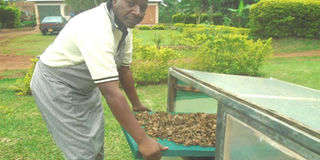Value addition earns him big juicy returns

Jacob Kato explains how he adds value to ggobe. Photo by Fred Muzaale
Uganda is endowed with a number of traditional vegetables, which are consumed in fresh form.
They include cabbage, bitter berries, okra, french beans, sukuma wiki, cowpeas and many others. Vegetables are a major source of vitamins and fibre. However, because vegetables are highly perishable and coupled with lack of storage facilities, farmers sell them quickly before they dry or wither.
In most cases, farmers are paid little as they cannot negotiate for good prices for their produce.
Value addition
Jacob Kato, a vegetable farmer who is a resident of Kyampisi Village, Kayunga District has decided to dry his cowpea commonly known as ggobe to extend his vegetable’s shelf life and earn more.
Ggobe is a traditional vegetable that is a delicacy to many people, especially in northern and eastern Uganda. Kato says initially he could sell his fresh vegetables to traders in Nakasero and Nakawa markets, who used to pay him little money as he was always in a hurry to sell.
However, he says, he used to see his grandmother dry the vegetable (ggobe), which she would later boil during scarcity.
The process
Upon maturity, Kato starts picking the leaves. He washes them with clean water before boiling in a saucepan for at least 40 minutes.
When they are cooked, he removes the water and takes them to a solar drier to dry. Drying takes two to three days, depending on the sunshine.
When they are fully dry, he removes them and grinds them in a mortar because he does not want his vegetable flour to mix with maize or cassava flour when he uses a commercial public milling machine.
The flour is then sieved to remove some hard particles after which it is then packed in containers of 200 grammes. Kato sells each pack at Shs5,000.
Market
Kato says he sells his produce to supermarkets in major towns including Kampala, Mukono and Jinja. He adds that sometimes he loses customers because he has not acquired a Q mark for his produce.
Acquiring a Q mark is his target as he wants to export his produce. He says in a month he sells about 400 packs and earns about Shs2.5m. After deducting all the expenses he says he remains with about Shs2m. In a plot of 50 by 50 metres he can get about Shs3.5m in two months.
Challenges
Kato’s profits reduce during dry seasons because he spends more on water for irrigation. “The water bills are enormous during dry seasons when we entirely depend on irrigation,” says Kato.
Also, he says pests eat his leaves, which leads to losses. This is because he does not use artificial pesticides because his product is organic.
Low cost technology
“I thought I could also do the same but in a better way by using solar driers,” Kato says.
He says he in 2014 invested about Shs800,000 in buying three small solar driers, which he currently uses to add value to the vegetable. He says ggobe matures 30 days after planting and that a farmer can harvest leaves for commercial purpose for at least four times in a period of four months.




